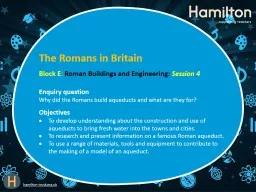

E Roman Buildings and Engineering Session 4 Enquiry question Why did the Romans build aqueducts and what are they for Objectives To develop understanding about the construction and use of aqueducts to bring fresh water into the towns and cities ID: 918959
Download Presentation The PPT/PDF document "The Romans in Britain Block" is the property of its rightful owner. Permission is granted to download and print the materials on this web site for personal, non-commercial use only, and to display it on your personal computer provided you do not modify the materials and that you retain all copyright notices contained in the materials. By downloading content from our website, you accept the terms of this agreement.
Slide1
The Romans in Britain
Block
E
:
Roman Buildings and Engineering: Session 4Enquiry questionWhy did the Romans build aqueducts and what are they for?ObjectivesTo develop understanding about the construction and use of aqueducts to bring fresh water into the towns and cities.To research and present information on a famous Roman aqueduct.To use a range of materials, tools and equipment to contribute to the making of a model of an aqueduct.
hamilton-trust.org.uk
Slide2How did the Romans supply their towns and cities with clean water?
Slide3Caesarea Aqueduct
Israel
Slide4Aqueduct of Miracles
Mérida, Spain
Slide5Les
Ferreres
Aqueduct (also known as Pont del Diable) Spain
Slide6Valens Aqueduct
Turkey
Slide7Aqueduct of Segovia Spain
Slide8Pont du Gard,
Nimes
, France
Slide9Activity time:
Research challenge!
We are going to research and present information about Roman aqueducts.
You need to explain what an aqueduct is and why the Romans built aqueducts. You also need to find out some information about a famous Roman aqueduct that is still in use today.
Slide10Researching a famous Roman aqueduct
Where in the world is it?
What is it called?
Why was it built?
Can you find out any interesting facts about it?What does it look like?
Slide11Presenting your information
Slide12Activity time: Aqueduct building!
Use 2 cardboard boxes for the base.
Cut away the front of the boxes and half of the sides.
Trim the remaining sides to about 10cm in height.Make a colonnade of arches using card strips 40cm long x 10cm wide. Your aqueduct needs to have a slight downhill slope so make each arch 0.5cm shorter than the one before it.
Glue the bottom 3cm of the arches together.
Slide13Activity time: Aqueduct building!
Make a slit down the side of the cardboard tubes.
Snip around the bottom with short cuts (about 1 ½ cm).
Decorate paper rectangles with a pattern of stone blocks and stick these to the cardboard columns.
Use the bottom flaps to stick the columns to the cardboard base at equal spacing across your 2 boxes. The first and last columns should wrap around the edge of the box.The middle one should wrap around the edge of both boxes to link them together.
These columns are 14cm apart
Slide14Activity time: Aqueduct building!
Hold a strip of card against the front of the first arch so that it is resting on the top of the columns.
Draw around the curve of the arch.
Draw a curve about 2.5cm below it.
Draw a curve about 1.5cm above it.
Draw a wedge shape in the centre.
Slide15Activity time: Aqueduct building!
Cut out the arch shape.
Draw radiating lines around the arch.
Now cut flaps along the top curve and fold them back.
Glue the flaps against the bottom of the card arch.Repeat for the other arches.
Slide16Activity time: Aqueduct building!
Add a second cardboard column to back of each arch.
Stick the flaps at the bottom of the columns onto the cardboard base so the slit encloses the back of each arch and holds it firmly in place.
Slide17Activity time: Aqueduct building!
Make the top of the aqueduct by drawing freehand parallel lines along a 10cm strip of card and marking the stones at right angles.
Turn the strip of card over and score lines 2cm in from the outside edges.
Draw stones on the top and bottom of both edges.
Fold the edges up to make the sides of the channel. Use coloured pencils to draw the water in the channel (make sure the lines go in the direction the water is flowing).
Slide18Activity time: Aqueduct building!
Place the stone top and the channel on top of the aqueduct to finish it.
If you are joining strips of card to make the channel long enough, make sure that each one is stuck beneath the one before so that the flow of water is downhill.
Slide19Effective group working!
How will you help each other?
What tasks will each person do?
How will you make decisions as a group?
Slide20Thinking about our models
What did your group do to work together effectively?
What do you like about your model?
What would you do differently if you did this activity again?